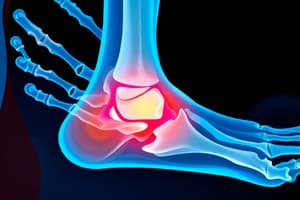Podcast
Questions and Answers
A patient presents with pain and dysfunction, and an evaluation reveals the presence of inflammation, swelling, heat, and redness. Which of the following phases of soft tissue healing is the patient MOST likely experiencing?
A patient presents with pain and dysfunction, and an evaluation reveals the presence of inflammation, swelling, heat, and redness. Which of the following phases of soft tissue healing is the patient MOST likely experiencing?
- Inflammatory Phase (correct)
- Proliferative Phase
- Remodeling Phase
- Maturation Phase
According to the PEACE acronym for acute soft tissue injury management, which of the following interventions should be AVOIDED during the initial stages of healing?
According to the PEACE acronym for acute soft tissue injury management, which of the following interventions should be AVOIDED during the initial stages of healing?
- Protection
- Elevation
- Compression
- Anti-inflammatories (correct)
During which phase of soft tissue healing is collagen formation (Type III) a primary characteristic?
During which phase of soft tissue healing is collagen formation (Type III) a primary characteristic?
- Resolution Phase
- Remodeling Phase
- Proliferative Phase (correct)
- Inflammatory Phase
A patient has a Grade 2 ligament sprain. Based on typical healing times, approximately how long might it take for the ligament to heal?
A patient has a Grade 2 ligament sprain. Based on typical healing times, approximately how long might it take for the ligament to heal?
Which of the following is the MOST appropriate intervention during the remodeling phase of soft tissue healing?
Which of the following is the MOST appropriate intervention during the remodeling phase of soft tissue healing?
A patient reports pain described as 'pain before tissue resistance'. This clinical sign is MOST indicative of which phase of tissue healing?
A patient reports pain described as 'pain before tissue resistance'. This clinical sign is MOST indicative of which phase of tissue healing?
A patient is in the proliferative phase of healing from a muscle strain. What is the MOST important consideration when progressing their exercise program?
A patient is in the proliferative phase of healing from a muscle strain. What is the MOST important consideration when progressing their exercise program?
Which of the following BEST describes a Grade 1 sprain?
Which of the following BEST describes a Grade 1 sprain?
During the remodeling phase, which type of collagen is remodeled into Type I collagen to increase tissue strength?
During the remodeling phase, which type of collagen is remodeled into Type I collagen to increase tissue strength?
According to the LOVE acronym, what does the 'V' stand for in the context of soft tissue healing management?
According to the LOVE acronym, what does the 'V' stand for in the context of soft tissue healing management?
Flashcards
What is a strain?
What is a strain?
Damage to the musculotendinous unit
What is a sprain?
What is a sprain?
Damage to a joint capsule or ligament
What is a dislocation?
What is a dislocation?
Complete displacement of a joint
What is a subluxation?
What is a subluxation?
Signup and view all the flashcards
What is tendinopathy?
What is tendinopathy?
Signup and view all the flashcards
What is synovitis?
What is synovitis?
Signup and view all the flashcards
What is hemarthrosis?
What is hemarthrosis?
Signup and view all the flashcards
What is bursitis?
What is bursitis?
Signup and view all the flashcards
What is a contusion?
What is a contusion?
Signup and view all the flashcards
What does PEACE stand for in injury management?
What does PEACE stand for in injury management?
Signup and view all the flashcards
Study Notes
Objectives
- Soft tissue lesions have varying definitions that must be distinguished.
- Soft tissue healing occurs in distinct phases.
- Each phase of soft tissue healing has general treatment recommendations.
- PEACE and LOVE acronyms are related to the management of soft tissue injury.
Soft Tissue Lesions
- A strain affects the musculotendinous unit.
- A sprain affects the joint capsule and ligaments.
- Dislocation is the complete displacement of a joint.
- Subluxation is the partial displacement of a joint.
- Tendinopathy is a tendon pathology caused by mechanical load.
- Synovitis is inflammation of the synovial membrane.
- Hemarthrosis refers to bleeding into a joint.
- Bursitis is the inflammation of a bursa.
- A contusion is bruising due to trauma.
Grades of Sprain/Strain
- Grade 1 involves stretching or microscopic tears, minimal swelling, localized pain, and almost normal range of motion (ROM).
- Grade 2 involves a partial tear of tissue, moderate swelling and bruising, and loss of ROM with significant pain.
- Grade 3 involves a complete tear, severe pain, swelling, bruising, and loss of ROM.
Healing Times by Grade
- Exercise-induced muscle injury can heal in 0-3 days.
- Grade 1 muscle injuries take 1-4 weeks to heal.
- Grade 2 muscle injuries require 3-12 weeks of healing.
- Grade 3 muscle injuries need 1-6 months to heal.
- Tendonitis heals in 3-7 weeks.
- Tendonosis requires 3-6 months to heal.
- Grade 1 ligament sprains heal in 2-8 weeks.
- A Grade 2 ligament sprain takes 2-6 months to heal.
- Grade 3 ligament sprains require 6-12 months for recovery.
- Meniscus/Labrum injuries need 3-12 months to heal.
- Fractures typically heal in 6-8 weeks.
Soft Tissue Repair
- The inflammatory phase involves assessing damage and clearing damaged tissue, lasting 4-6 days up to 2 weeks.
- The proliferative phase involves beginning repairs, lasting 4-24 days, but up to 6 weeks in areas with limited circulation like tendons.
- Remodeling involves strengthening and completing the repairs and can last from 3 weeks to 2 years based on the tissue and damage.
Inflammatory Phase Details
- Chemical signals like histamine and bradykinin induce vascular changes and edema.
- Chemotaxis attracts leukocytes and other immune cells.
- Clot formation occurs.
- Phagocytosis via leukocytes and macrophages takes place.
- Clinical signs of inflammation include redness, swelling, heat, and pain.
- Movement causes pain before tissue resistance.
Inflammatory Phase Management
- Control stress to the injured tissue through protection.
- Reduce swelling.
- Control, but do not interfere with, the inflammatory response.
- Pain should guide management.
- PEACE: Protection, Elevation, Avoid anti-inflammatories, Compression, and Education.
PEACE Acronym
- P: PROTECTION, avoid activities that increase pain during the first few days after injury
- E: ELEVATION, elevate the injured limb higher than the heart as often as possible
- A: AVOID ANTI-INFLAMMATORIES to avoid reduced tissue healing, avoid icing
- C: COMPRESSION, use elastic bandage or taping to reduce swelling
- E: EDUCATION, let nature play its role and avoid unnecessary passive treatments / medical investigations
Proliferative Phase Details
- Growth of capillary beds occurs.
- Collagen formation (Type III) occurs.
- Granulation tissue forms.
- Movement causes pain synchronous with tissue resistance.
- Inflammation signs decrease.
Proliferative Phase Management
- Maintain controlled stressing of tissues by progressing ROM, intensity and frequency and targeting restrictions.
- Tissue remains fragile, so avoid quick and explosive stressing.
- Pain should be the guide.
- LOVE: Load, Optimism, Vascularization, Exercise.
Remodeling Phase Details
- Scar tissue matures.
- Scar tissue contracture occurs.
- Type III collagen remodels to Type I.
- Collagen aligns to stress.
- Inflammation signs are absent.
- Movement causes pain at end-range tissue resistance.
Remodeling Phase Management
- Progressively stress tissues by increasing volume, load, and intensity.
- Incorporate rapid, quick, and power movements.
- Progress toward returning to prior level of function.
- Avoid pain, but some discomfort is normal when pushing limits.
- LOVE: Load, Optimism, Vascularization, Exercise.
Factors Affecting Healing
- Lifestyle Factors: Diet, activity levels, smoking/alcohol, and stress impact healing.
- Comorbidities: Age, obesity, diabetes, and immunocompromised conditions affect healing.
Application Cases
- For each of these cases, it is important to:
- Identify which phase of healing the patient is experiencing.
- Determine when the patient will move to the next phase.
- Decide on one piece of education to provide the patient about their phase of healing.
- Determine one appropriate intervention for the patient.
Case 1
- A 16-year-old has a Grade 1 sprain of the ATFL 36 hours prior.
- There is slight swelling in the ankle
- Pain is at its worst, a 4/10 in the last 24 hours.
- Pain at end-range dorsiflexion and inversion is present.
- There is no pain with ambulation, but there is pain with running, jumping, and cutting.
- The patient wants to be ready to play in the state championship tomorrow night.
Case 2
- A 40-year-old reports a Grade 2 hamstring strain 2 months prior.
- There is absence of swelling.
- No pain occurs with daily activities, but discomfort with stairs and running (2/10).
- There is slight pain (2/10) at end-range stretch.
- The patient hopes to be prepared for slow-pitch softball season in a couple of months.
Case 3
- A 23-year-old strained his back 2 weeks prior while moving into a new apartment.
- He is slowly regaining his ROM, but still has pain (4/10) at end-range flexion and rotation.
- There is no pain at rest, except sitting for more than 30 minutes (4/10).
- The patient wants to return to running and be ready for a plane ride to Germany in 1 month.
Studying That Suits You
Use AI to generate personalized quizzes and flashcards to suit your learning preferences.




